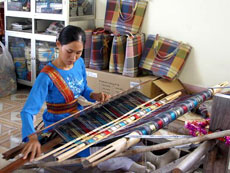Everyday, a Cham woman called Gai sits by an old loom in her soil-walled house in My Nghiep Village to weave fabric. The work creates a merry clop sound when the loom components hit together.
|

A Cham woman attentively weaves fabric in
My Nghiep Village
|
The simple but good-to-listen-to hollow sound goes echoing amidst the laughs and giggles of the children and the chatting of the adults in the traditional Cham weaving village in the central province of Ninh Thuan.
Gai says it takes her a few days or even a week to weave a piece of brocade fabric measuring 4-25 centimeters wide and up to 200 centimeters long on the dalah loom, depending on the length, the colors and designs of the product. |
In the quiet little village, other Cham women weave bolts of fabric 40-100 centimeters wide and up to 200 centimeters long on ban looms in their houses during the daytime and even in the evening before their major festivals or when big orders come.
The size of the Cham fabric is made differently based on the patterns and the purpose of its use. This fabric is then tailored into headscarves, clothes, woman’s sarongs, wallets and purses, handbags and boxes to store small useful items or decorations.
Cham people use both ban and dalah looms to weave fabric, but the primary difference between these tools is that the ban loom requires the weavers to sit flat on the floor when they are doing their job while the weavers with the dalah loom sit on a chair.
In the past, Cham people had to make thread from cotton seeds and dye it with the resin of leaves and trees to produce the colored thread they wanted. Everything is much easier nowadays as they can find various types of thread available in the colors of their choice.
However, Gai said skill, experience and creativity are the irreplaceable factors for weavers to create unique fabric and patterns and colors. This original patterned fabric has earned a reputation for the village.
It is said that a queen taught the villagers of My Nghiep Village to weave brocade fabric in the old days and this traditional occupation has been handed down from generation to generation for centuries.
Nowadays in the village, it is common to see children playing near the loom when their mothers are weaving fabric, and in this way, children can get first hand learning of the weaving at a very young age.
More than 500 looms still work in My Nghiep and the majority of villagers use these tools to weave fabric with around 40 traditional and modern patterns for sale on the spot in the village and in cities around Vietnam as well as for export to Japan, Europe, the United States and many other destinations.
Tourists can buy items with prices ranging from just VND5,000 to more than VND100,000 at weaving workshops and shops in the village after their tours to see Cham girls weaving the fabric and an insight into the simple life of the quiet village.
As My Nghiep is around 10 kilometers from the heart of Phan Rang Municipal, the village is approachable by taxi or motorcycle taxi from the municipal.